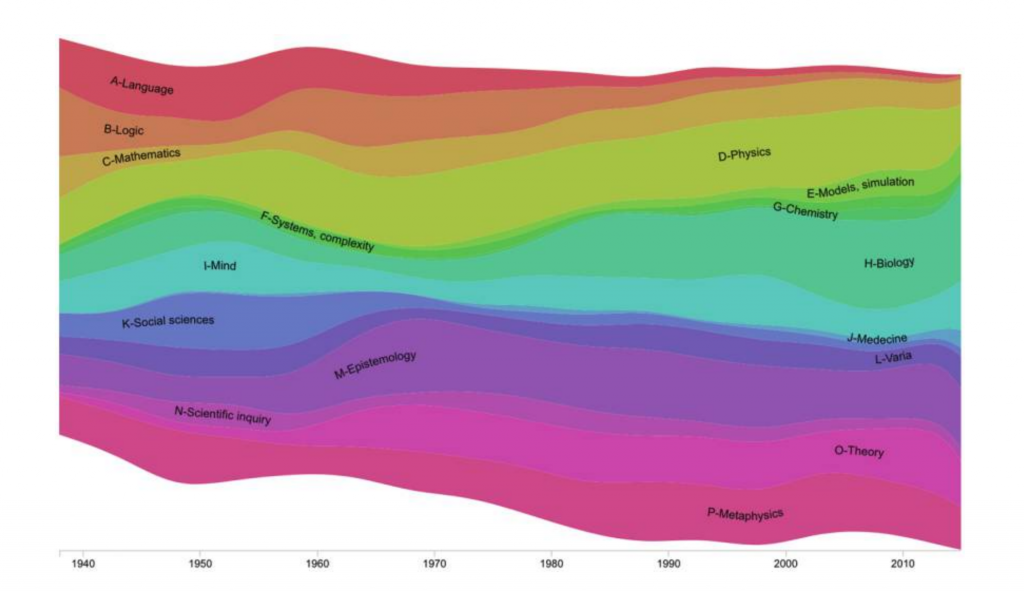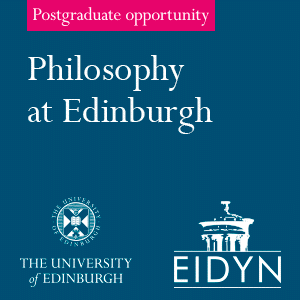A “Data-Driven” History of Philosophy of Science
“Philosophy of science is what philosophers of science do. But what is it that philosophers of science do?” A team of researchers has just published their answer, based on computational text-mining of every issue of the journal Philosophy of Science published from 1934-2015.
In “What Is This Thing Called Philosophy of Science? A Computational Topic-Modeling Perspective, 1934-2015,” forthcoming in HOPOS: The Journal of the International Society for the History of Philosophy of Science, authors Christophe Malaterre, Jean-François Chartier, and Davide Pulizzotto (Université du Québec à Montréal) argue that their method complements other current historical approaches.
They say their methods make it possible to “comprehensively analyze the semantic content of large corpuses of full-text documents, thereby providing an empirical basis for content-related studies, be they synchronic or diachronic.” As for what they learned, and how, they write:
we apply these methods to the complete full-text corpus of Philosophy of Science from its very start in 1934 up until 2015 to empirically investigate which research questions philosophers of science have been concerned with and how these questions evolved in the last 82 years. By applying topic-modeling algorithms, we identified 126 key topics that were present in the journal articles during this period. We also analyzed how these topics evolved in significance over time. Our findings concur with well-known episodes in the history of philosophy of science, such as the rise and fall of logical empiricism (1930s–1970s), but they also document other trends, such as the strong appearance of a philosophy of biology in the 1980s and mostly in the first decade of the 2000s as well as the emergence of a significant interest in models and simulations in the 1990s…
These 126 topics show a great diversity of interests exhibited by philosophers of science, ranging from questions about logic and philosophy of language to issues that are usually thought of as more metaphysical, for example, natural kinds or causation, including also a broad spectrum of epistemological questions about induction, confirmation, and the scientific method.
Here are some more specific findings:
- 16% of the topics relate to philosophy of language, logic, and mathematics
- 10% of the topics relate to the physical sciences
- 9% relate to the biological sciences
- 12% relate to epistemology
- 13% relate to theory (regarding scientific theories, explanation)
- 13% relate to metaphysics
The following graph shows how the popularity of topics in philosophy of science has changed over the studied period:

“Diachronic evolution of topic categories in Philosophy of Science, 1934–2015. The width of each ‘stream’ is proportional to the probability of each category in the corpus.” From “What Is This Thing Called Philosophy of Science?” by Malaterre, Chartier, and Pulizzotto.
Observations from the authors:
- The dominance of language and logic-related topics from the start of Philosophy of Science in 1934 up until the 1970s, with language consistently accounting for about 20% of the top topics and logic coming in two bursts, one before the 1950s and a stronger one from the 1950s to the 1970s. These episodes were then followed by a sharp decline and a total disappearance of language and logic within top-20 topics from the 1980s onward.
- Topics related to mathematics, in contrast, were present more or less continuously across the whole existence of the journal, with an average of about one topic per period. Because several of these mathematics-centered topics include terms that will be mobilized by any sufficiently formalized scientific theory (e.g., variables, state-space, or theorem), one possibility could be that they somehow piggyback on a number of physics-related topics.
- Physics topics [are] reasonably well represented in Philosophy of Science, although not in any dominant fashion… Note how they appear within the top-20 topics in mainly two periods: a first period from the 1950s to the 1970s with a simultaneous interest in relativity and quantum mechanics and a second period from the 1990s up till the 2010s, much more focused on quantum mechanics and particle physics.
- The emergence in the first decade of the 2000s of several topics that are somehow connected to the physical sciences (although not exclusively) and that concern models and simulations (topics 100, 116, 136). These models-related topics could correspond to a relative shift of interest away from the traditional topics of the physical sciences to modeling and simulation, which are topics that are not restricted to physics but also concern other scientific disciplines.
- From the journal’s start in 1934 until the 1960s, one could find only two biology-related topics… Toward the very end of the 1970s to the early 1980s, one witnessed a very strong development of biology-related topics, especially topics on natural selection, population genetics, and the concept of adaptation, with an even stronger presence from the first decade of the 2000s onward.
- Topics related to philosophy of mind broadly construed—including perception, vision, behavior, intentionality, and the neurosciences as well as psychology and therapy—were found to be irregularly present throughout the whole period of existence of the journal.
There is much more to the article, which you can read here.


